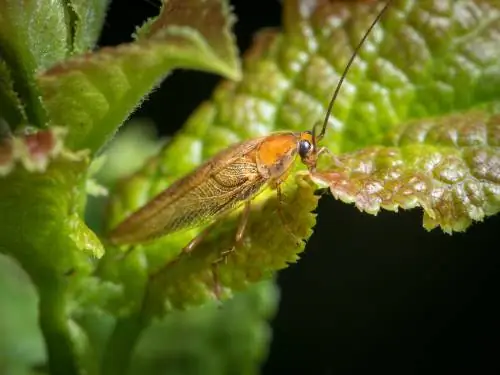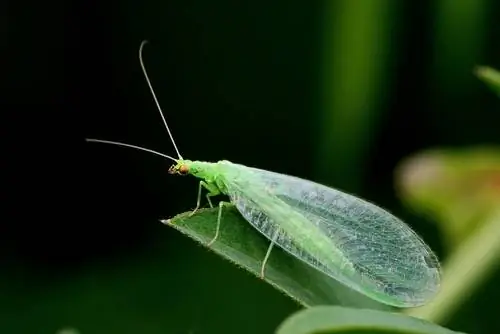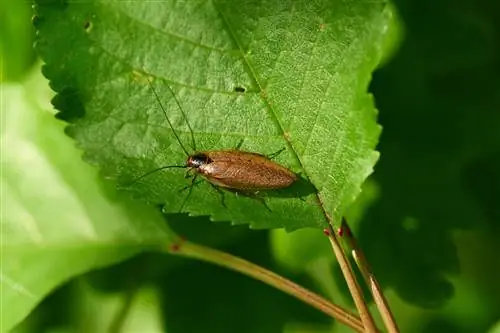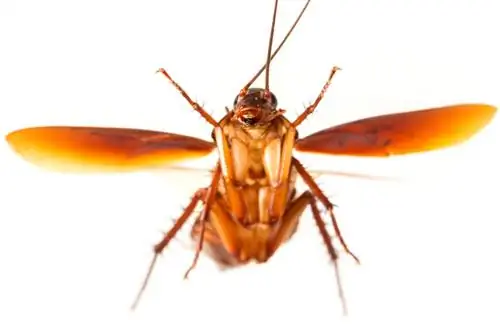- Author admin [email protected].
- Public 2024-01-05 20:48.
- Last modified 2025-01-23 11:21.
Amber cockroaches have appeared more and more frequently in Germany in recent years. Favored by climatic changes, the insects are increasingly spreading to the north. But their way of life is very special and can even be useful.
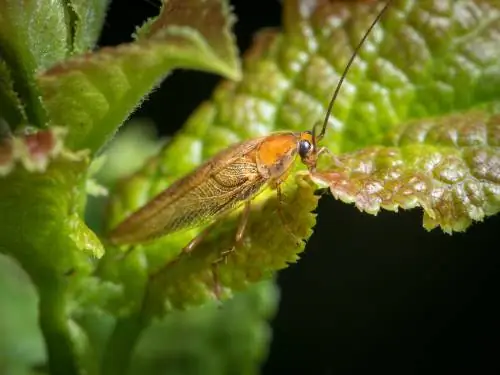
Are amber cockroaches harmful or beneficial?
Amber cockroaches are harmless insects that are neither harmful nor dangerous to humans. They feed on dead plant material and promote the formation of humus in the forest. Control is usually not necessary and they are even considered useful animals in the ecosystem.
Harmful or useful?
The amber forest cockroach is completely harmless to humans. It is not considered a pest and only occasionally finds its way into houses and apartments. Since the insects feed exclusively on plant material in an advanced stage of decomposition, they find no source of food in human habitations and die within a very short time.
Amber cockroaches are neither harmful nor dangerous to humans. They even take on important tasks in the forest ecosystem.
Humus formation
Forest cockroaches are involved in the decomposition of plant material and accelerate the formation of humus. In this way, amber cockroaches ensure that the plant remains are utilized and the nutrients they contain are made available to plants more quickly. Although forest cockroaches have a more limited range of food than cockroaches, they can provide valuable services in the compost, where the animals also seek protection from cold temperatures.
Excursus
Cockroaches for kitchen waste
In East China's Shandong Province, people are taking advantage of cockroaches instead of fighting them. Every day, tons of kitchen waste is generated from restaurants, which contains a lot of foreign substances, water and oil. The organic waste is recycled by the cockroaches. The insects produce heat, which is used to grow vegetables in winter. If the cockroaches die, they are processed into protein-containing pet food.
Is control necessary?
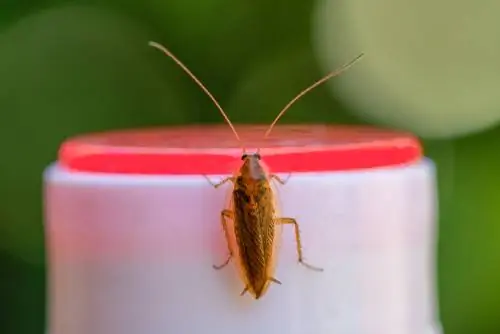
Amber cockroaches are neither dangerous nor harmful
Since amber cockroaches are not stored product pests and do not transmit diseases, control is neither necessary nor recommended. A massive occurrence is encouraged by warm summer temperatures and mild winters, which means that amber cockroaches are occasionally viewed as a nuisance. Various cities such as Stuttgart and Munich were affected by this in 2017 and 2018. However, they only appear in large numbers in houses in exceptional cases.
Identify species
Use a flashlight to help check the insect's behavior. Cockroaches flee immediately when the light is turned on. They hide in crevices and niches under cupboards. Forest cockroaches show no flight instinct. They crawl around aimlessly during the day and move towards the light source at night.
Avoid chemical agents
Insecticides kill cockroaches within a very short time. However, numerous substances also pose he alth risks. Insecticides do not work selectively. Other insects can also be killed by the use of chemical agents.
Attract
If there are several animals in the apartment, you can build a trap and attract the insects with attractants. A plastic bottle with a wide opening can be converted into a trap in just a few steps. The insects are attracted by the smell of the food and fly in. Since the animals can barely hold on to the smooth surface, there is no escape from the trap. In order not to harm the forest cockroaches, you should check the containers regularly and release the animals in the garden.
How to build the trap:
- Cut the top third of the bottle
- fill the bottom part of the bottle with leaves and plant residues
- Place the upper part with the opening into the lower part
Tip
If necessary, set up several of these traps around the home. You don't have to worry about the food being particularly fresh.
Prevention
Fit your windows with fly screens if you want to ventilate with the lights on in the evening. To ensure that no forest cockroach gets into your home, you should keep the windows closed during peak activity in the evening.
Essential oils
Roaches don't like the strong smell of different oils. Catnip, peppermint and clove oil have been proven to scare away substances. Garlic cloves or crushed catnip leaves also have a deterrent effect on insects. Essential oils can be evaporated in a fragrance lamp (€13.00 on Amazon). If you find the intense smell off-putting, you can plant intensely scented plants in pots.
Profile
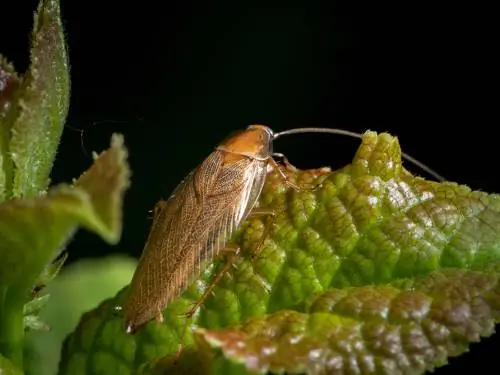
The amber cockroach gets its name from its beautiful coloring
The amber cockroach (Ectobius vitiventris) belongs to the forest cockroach subfamily and originally comes from southern Europe. It requires warm temperatures and cannot develop in areas with extended cold periods. Rising temperatures increase the insects' probability of survival, so that they increasingly spread northwards. In midsummer the forest cockroaches sometimes fly in large numbers. The name comes from the light brown color, which is reminiscent of amber.
General characteristics
This species is comparatively slender and long. With its six legs, the amber wood cockroach can move quickly. The insects are between nine and 14 millimeters long, with their antennae being as long as the body. You can clearly identify amber cockroaches by the color of the pronotum. This is colored light brown and translucent at the edge.
The thorny legs, which are typical of forest cockroaches, are also striking. In amber cockroaches, the wings extend beyond the tip of the abdomen. Some of them can be finely spotted. Large dark spots are absent, distinguishing the species from similar cockroaches.
Other identifying features:
- one or two thorns on middle and hind legs
- Female egg package clearly visible and slightly curved
- Surface of the egg packets with fine longitudinal ribs
Lifestyle
Amber cockroaches are nocturnal and hide during the day under leaves and stones or under flower pots and in roller shutter boxes. Particularly high flight activity is noticeable in warm weather. Both males and females then fly frequently.
Development
The female insects lay their egg packages from summer to autumn. Nymphs only hatch after overwintering the following spring. Shortly before the second overwintering, the larvae shed their skin once or twice. The final molt to become an adult insect occurs the following summer. This two-year development is typical of the amber cockroaches and other species of the genus Ectobius. It is not yet known how old the adult insects can live. Mass proliferation can occur in particularly hot summer months.
Excursus
Egg packages with feeding protection
The egg packages, also called oothecae, are typical of all cockroaches and differ between species in terms of shape and coloring. The insects have developed special protection against predators. The egg packets are surrounded by a hard shell containing calcium oxalate. This substance is also present in many plants such as rhubarb or parsnip and is considered the main component of kidney stones.
Winter
Amber cockroaches overwinter in protected habitats under leaves or in compost heaps. Occasionally the insects look for suitable winter quarters in houses and apartments. The nymphs last two winters from the time they lay their eggs until they molt into adult insects.
Distribution and habitat
Ectobius vitiventris is widespread in southern Europe. Originally, Ticino in Switzerland represented the northern limit of the natural range. In the 1980s, the species became increasingly widespread in northern Switzerland. The amber cockroach was first detected in South Baden in 2002. The species' distribution area now extends from Rhineland-Palatinate to Bavaria and Thuringia. The insects were discovered in NRW in 2015.
Good to know:
- Cold impairs development
- Development occurs faster under higher temperatures
- ideal temperature: 30 degrees Celsius
House and apartment
Because amber cockroaches are capable of flight, they are occasionally found indoors. It is noticeable that the animals appear more often in houses that are in the immediate vicinity of a forest. Amber cockroaches are attracted by the light and probably also by the heat radiation from house facades.
While most cockroaches have no chance of survival inside buildings due to low humidity, amber cockroaches can survive a little longer in houses. Here the insects are also active during the day and crawl around aimlessly and clumsily on the ground. The species cannot reproduce in apartments.
Natural habitats
In the wild, the insects live in low bushes and on the edges of forests. Since they feel particularly comfortable in hedges, amber cockroaches also appear in the garden. They crawl on leaves and twigs of various shrubs, although they do not specialize in any plant species. The animals can also be observed under flower pots. The insects are now found in urban gardens and parks.
This is what amber cockroaches need:
- Vegetation: loose planting with low bushes
- Light: sunny places
- Floor: sheltered and warm places
Confusion
The amber wood cockroach can easily be confused with other cockroaches, which is why its appearance causes fear or discomfort in many people.

Forest Cockroaches
The species in this subfamily live on the forest floor and have a similar diet. They are between nine and 14 millimeters long and are light brown to brown in color, which is why the species can be easily confused. The amber forest cockroach stands out for its reddish tones.
cockroaches
There is a greater risk of confusion between the amber cockroach and the German cockroach, which occurs as a pest of stored goods. Both species are similar in shape, size and color. The most important difference from the cockroach is the pronotum. But the cockroaches also differ in behavior. While the German cockroach is flightless and can only survive in buildings in Central Europe, the amber cockroach moves by flying and avoids houses. The storage pest does not crawl around aimlessly, but immediately crawls into a crevice.
| Size | Neckshield | House pest | |
|---|---|---|---|
| German Cockroach | 12 to 15 mm | brown with two dark vertical stripes | yes |
| Common Wood Cockroach | 9 to 12 mm | dark spot | no |
| Real forest cockroach | 7, 5 to 11 mm | dark brown to black | no |
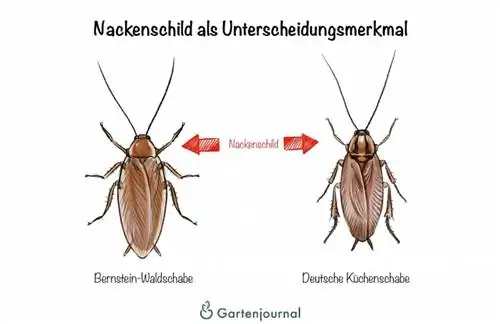
Food
Like all forest cockroaches, the amber cockroach feeds primarily on plant-based food. The insects have specialized in the utilization of dead plant materials that are already in the decomposition stage. Fallen leaves or plant residues on the compost provide valuable sources of nutrition.
Create natural habitat
Forest cockroaches are favored by certain climatic conditions, so they can appear in large numbers. However, this also means that natural enemies are becoming more common. The populations of different insectivores are determined by the food supply, so there are constant natural fluctuations between predator and prey. Additionally encourage insect predators in your garden to mitigate mass spread.
Natural Enemies:
- Birds: Reed Warblers, Great Gray Shrikes, Thrushes
- Reptiles: turtles, iguanas, geckos
- Arthropods: Spiders
Tip
The amber cockroach feels particularly comfortable in lush ivy tendrils. Avoid similar plants in your garden if you do not want to provide the cockroaches with a habitat.
A diverse garden
Natural enemies of cockroaches feel particularly comfortable in a habitat that consists of various small-scale mosaics. Make your garden as varied as possible with piles of dead wood, dry stone walls and flower-filled beds. If you have space available, you can create a wetland habitat with a pond. You can also create different living spaces on the balcony by equipping flower pots with local wild plants. A zinc tub is ideal as a mini pond.
| Lifestyle | specialized in forest cockroaches | ||
|---|---|---|---|
| hunger wasps | parasitizing in egg packets | yes | |
| Fan Beetle | parasitizing in egg packets | no | |
| Jewel wasp | parasite in adult cockroaches | no |
Frequently asked questions
What to do against amber cockroaches in the apartment?
Occasionally an amber forest cockroach also gets lost in apartments and houses because the flying animals are attracted to light sources and warm house facades. If an animal is crawling aimlessly out of the ground, there is no need to panic. However, the six-legged friends are very agile. Place a glass over the insect and slide a piece of paper underneath. You can then take it outside and leave it free.
What do amber cockroaches eat?
Like all forest cockroaches, the insects feed on dead plant remains. Their diet consists mainly of fallen leaves and wilted herbaceous plants that are already rotting. The animals are not food pests because they can't do much with human food.
Do amber cockroaches transmit diseases?
Cockroaches can transmit many diseases because of their lifestyle. They spread bacteria, fungi and viruses that can cause various diseases upon contact. Molt residue occasionally causes allergies. On the other hand, forest cockroaches, which also include the amber cockroach, are completely harmless. They do not crawl around in rubbish scraps or waste pits, but rather live on the forest floor. This means that they are not considered as disease vectors.
Are amber cockroaches harmful?
This species belongs to the forest cockroaches and has a limited range of food. Their diet includes dead plant remains. The insects disdain human food or leftover food, so they do not act as stored food pests. If an animal gets into your apartment, you don't have to worry. Amber cockroaches are not harmful.
How long do amber cockroaches live?
The lifespan of adult amber cockroaches is not yet known. It takes up to two years for cockroaches to develop from the egg packets. The nymphs molt several times and overwinter. This development can occur more quickly under particularly warm conditions.

